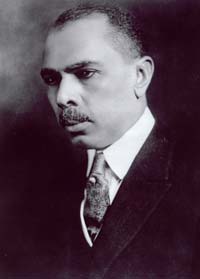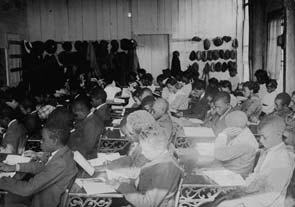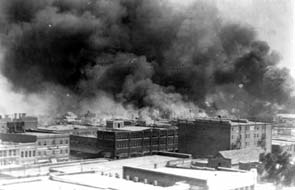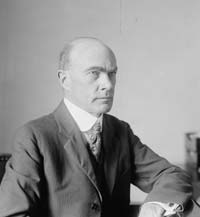The Negroes’ Temporary Farewell
Jim Crow and the Exclusion of African Americans from Congress, 1887–1929
Anti-Lynching Legislation Renewed
 A civil rights pioneer, James Weldon Johnson was the NAACP’s executive secretary and the chief congressional anti-lynching lobbyist.Image courtesy of Library of Congress
A civil rights pioneer, James Weldon Johnson was the NAACP’s executive secretary and the chief congressional anti-lynching lobbyist.Image courtesy of Library of CongressThe passage of anti-lynching legislation became one of the NAACP’s central goals. Slow to join the cause of pursuing legislation to remedy lynching because of the leadership’s concerns about the constitutionality of such an undertaking, the NAACP eventually embraced the movement, using it to educate the often ambivalent American public so as to jar it into substantive action.
Statistics supported the NAACP’s increased urgency in the anti-lynching campaign. Between 1901 and 1929, more than 1,200 blacks were lynched in the South. Forty-one percent of these lynchings occurred in two exceptionally violent states: Georgia (250) and Mississippi (245).123 The NAACP report, Thirty Years of Lynching in the United States, 1889–1919, created momentum for congressional action. The anti-lynching effort provided the NAACP valuable experience waging a mass public relations campaign and mastering the art of congressional relations.124 In the 1920s, through the organizational leadership and diverse talents of its secretary, James Weldon Johnson, the NAACP became a significant vehicle for marshaling public opinion. Johnson’s biographer describes him as “truly the ’Renaissance man’ of the Harlem Renaissance”—a poet, composer, writer, and activist.125 Acting as the group’s chief congressional lobbyist, he pushed for the reduction scheme during the larger congressional debate over reapportionment and decisively shaped the NAACP’s campaign against lynching. Of his anti-lynching lobbying experience, Johnson recalled, “I tramped the corridors of the Capitol and the two office buildings so constantly that toward the end, I could, I think, have been able to find my way about blindfolded.”126
Pushed vigorously by Johnson and NAACP assistant executive secretary Walter White (a civil rights activist from Atlanta), anti-lynching reform awaited only a legislative entrepreneur in Congress and, regrettably, a triggering event. Activists found Representative Leonidas C. Dyer to be a willing ally. Dyer, a Spanish-American War veteran and a former aide to Missouri Governor Herbert S. Hadley, represented a thin sliver of the southern and eastern sections of St. Louis. Heavily industrialized, part of the district hugged the Mississippi River and included growing African-American neighborhoods.127 Since his election to the House in 1911, Dyer had demonstrated a disposition toward advocating for the black community.128
Dyer had a front-row seat to some of the nation’s most virulent wartime race violence. In the summer of 1917, just across the Mississippi River from his district, a riot in East St. Louis, Illinois, drew national attention and widespread condemnation. A hub for southern blacks migrating northward, East St. Louis had seen its black population triple in the first decade of the 20th century. Its racial tensions, stoked by competition for jobs and prejudice, struck a chord among many white northerners apprehensive about black migration. On July 1, 1917, white assailants drove through a black neighborhood, firing indiscriminately. Two plainclothes police officers sent to investigate the disturbance arrived in a vehicle similar to the one driven by the shooters. Fearful residents mistakenly opened fire on the policemen, both of whom were killed. White residents’ attempt to retaliate on July 2 flared into a merciless episode of mob sadism. The death toll climbed to 47 persons, including 38 African-American men, women, and children. Much of the black population fled the city.129 On the House Floor, Dyer decried the event as one of “the most dastardly and most criminal outrages ever perpetrated in this country.” Large numbers of refugees flowed across the river and into his district, compelling Dyer to tackle the problem of lynching and mob violence.
The rash of wartime mob violence nationwide provided new impetus for legislative action.130 After months of consultation with legal experts and the NAACP, Representative Dyer introduced H.R. 11279 on April 18, 1918, “to protect citizens of the United States against lynching in default of protection by the States.” Dyer’s bill, which provided the blueprint for all subsequent NAACP-backed anti-lynching measures, sought to charge lynch mobs with capital murder charges and to try lynching cases in federal court. It levied on each county where a lynching occurred, a fine of between $5,000 and $10,000 that would be paid to the victim’s immediate family or, if none existed, to the U.S. government to facilitate prosecution of the case. The Dyer Bill also mandated jail time and imposed a fine of up to $5,000 on state and local law enforcement officials who refused to make a reasonable effort to prevent a lynching or surrendered a prisoner in their custody to a lynch mob. Finally, the bill sought to establish guidelines for fair courtroom proceedings by excluding lynch mob participants and supporters from juries.131
 In 1917, 75 sixth-graders shared a single room and teacher in segregated Muskogee, Oklahoma.Image courtesy of Library of Congress
In 1917, 75 sixth-graders shared a single room and teacher in segregated Muskogee, Oklahoma.Image courtesy of Library of CongressDyer’s rationale was elegantly simple: Lynching—and states’ refusal to prosecute the perpetrators—violated victims’ 14th Amendment rights. Anticipating that Members would object to the bill because it involved federal control over social policy, he cited the slate of child labor laws the chamber had enacted and Congress’s December 1917 passage of the 18th Amendment, which forbade the production, transportation, or sale of alcohol within the United States: “If Congress has felt its duty to do these things, why should it not also assume jurisdiction and enact laws to protect the lives of citizens of the United States against lynch law and mob violence? Are the rights of property, or what a citizen shall drink, or the ages and conditions under which children shall work, any more important to the Nation than life itself?”132 In the Democrat-controlled 65th Congress (1917–1919), however, the measure remained stuck in the Judiciary Committee.
But advocates’ hope was renewed when Republicans gained majorities in the House and Senate at the start of the 66th Congress in 1919. In early 1921, James Weldon Johnson paid his first visit to Representative Dyer’s office, recognizing that the St. Louis Representative was a valuable contact.133 Throughout this process, the NAACP played a significant role in keeping the issue alive in Congress, and at several junctures, Johnson bolstered Dyer, urging him not to accept compromises to attain passage of legislation and encouraging him to resist pressure from the Republican Conference to abandon legislation many of his colleagues felt was unpopular.134
Under the NAACP’s intense lobbying pressure, the House began to move toward consideration of a bill derived from Dyer’s earlier efforts—first adopting a rule for consideration and then, in early January 1922 commencing consideration on the legislation.135 Southern opponents attempted to impede debate several times, refusing to come to the House Chamber so as to prevent a quorum. On such occasions Speaker Frederick H. Gillett of Massachusetts ordered the chamber doors locked and dispatched the Sergeant at Arms to search for errant Members.136 The debate came to a head on January 25 and 26, 1922, when the House considered a bill that contained many of the essentials of Dyer’s original measure. Though the provision seeking to ensure an impartial jury had been removed, the bill sought to levy a $10,000 fine on counties where lynchings occurred—as well as on counties through which victims were transported.
Southern Democrats rebuffed the measure, mustering familiar practical and constitutional defenses. Hatton W. Sumners of Texas, a Dallas attorney who later served 16 years as chairman of the House Judiciary Committee, led the defense. In two lengthy debates, Sumners compared the bill to an act of legislative “mob” violence and suggested Congress let southern states resolve the lynching issue on their own. “I say to you that you cannot pass this bill unless you pass it under the influence of the same spirit which this bill denounces, viz., the mob spirit,” Sumners said to laughter and applause on the House Floor. “You say that the folks down in the South are not doing this thing fast enough, and the folks in the South say the officers are not doing this thing fast enough, and you each get ropes and they go after the criminal and you go after the Constitution.”137
African Americans packed the House Gallery, intensely monitoring the debate, and on several occasions they cheered loudly, in violation of gallery rules. Some traded derogatory barbs with southern House Members below on the floor, whose speeches repeatedly referred to NAACP activists as “race agitators.”138 The glare of publicity pushed cautious House leaders to move swiftly for a vote. In the end, the Dyer Bill passed the Republican-controlled chamber on January 26, 1922, by a vote of 231 to 119, with four Members voting “present” and 74 others not voting.139 Among the 119 who voted “no” were four future Speakers of the House, each a southern Democrat who eventually presided over the chamber after Democrats assumed control of the House in 1931: John Nance Garner of Texas, Joseph Byrns of Tennessee, William Bankhead of Alabama, and Sam Rayburn of Texas.140
In the Senate, a combination of ambivalent Republican backing and spirited southern opposition doomed the Dyer Bill to legislative limbo. It withered in the Judiciary Committee under the unsympathetic oversight of Chairman William Borah of Idaho, who doubted its constitutionality. Nevertheless, Borah pledged not to block consideration of the measure if a majority of his colleagues assented. The measure passed out of the committee 8 to 6 in the summer of 1922—with Borah dissenting.141 The NAACP proceeded to engage in a formidable public campaign, increasing direct pressure on Majority Leader Henry Cabot Lodge of Massachusetts (who faced re-election that fall). Lodge, who had authored the Federal Elections Bill in 1890, had greatly moderated his previously progressive stance on federal oversight of black civil rights. He reluctantly brought the measure to the Senate Floor in September, but his choice of a manager to shepherd the bill through debate—Samuel Shortridge, California’s junior Senator and a relative novice—suggested he had little enthusiasm for the endeavor. Byron (Pat) Harrison of Mississippi swiftly upstaged Shortridge by gaining control of the debate. Further consideration was forestalled until after the November 1922 elections, relieving Senators of electoral pressure.142
 A mix of black and white British members of the NAACP protested the lack of anti-lynching laws in the United States in hopes of bringing more international attention to the epidemic.Image courtesy of Library of Congress
A mix of black and white British members of the NAACP protested the lack of anti-lynching laws in the United States in hopes of bringing more international attention to the epidemic.Image courtesy of Library of CongressWhen the bill came up for consideration in late November after the elections, southern Members again halted Shortridge with parliamentary maneuvers. As he had with the reduction issue two decades earlier, Alabama’s Oscar Underwood, now Senate Minority Leader, played a key role in killing the Dyer measure. Underwood threatened Lodge and the Republicans with a filibuster that would shut down end-of-session business in the Senate. Fearful they would be unable to secure a ship subsidy bill desired by the Harding administration, the members of the Senate Republican Conference voted to abandon the Dyer Bill. Though Representative Dyer reintroduced the measure in each new Congress in the 1920s, it failed to gain significant political traction. However, the public awareness campaign relentlessly pushed by the NAACP likely contributed to a general decline in lynching after the 1920s. It would be 15 years before Congress would seriously consider the subject again. In the words of historian Robert Zangrando, anti-lynching legislation was “displaced by the indifference of its friends and the strategy of its enemies.”143
Footnotes
- Carter et al., Historical Statistics of the United States: Government and International Relations 5: 252–255.
- William B. Hixson, Jr., “Moorefield Storey and the Defense of the Dyer Anti-Lynching Bill,” New England Quarterly 42 (March 1969): 65–81; Robert L. Zangrando, The NACCP Crusade Against Lynching, 1909–1950 (Philadelphia: Temple University Press, 1980): 18–19, 80–83, 214.
- The standard biography on Johnson is Robert Fleming, James Weldon Johnson (New York: Twayne Publishers, 1987).
- For more on Johnson and his role in lobbying for the Dyer Bill, see his memoir, Along This Way (New York: DaCapo Press, 2000; reprint of 1933 Viking Press edition): especially pages, 361–373; quotation on page 363.
- Congressional Directory, 65th Congress; Biographical Directory of the United States Congress, 1774–Present, available at http://bioguide.congress.gov.
- Zangrando, The NAACP Crusade Against Lynching, 1909–1950: 42–43.
- Ibid., 36–37.
- Congressional Record, House, 65th Cong., 1st sess. (9 July 1917): 4879; Congressional Record, House, 65th Cong., 1st sess. (6 July 1918): 8827. See also Zangrando, The NAACP Crusade Against Lynching: 43. The East St. Louis tragedy epitomized wartime racial violence in cities—spurred in large measure by the growing influx of southern blacks and immigrant whites and increased competition for industrial employment and housing. Over the next two years, riots occurred in Houston, Texas; Chester, Pennsylvania; Washington, DC; Knoxville, Tennessee; Omaha, Nebraska; and Chicago, Illinois. The summer of 1919, known widely as the “Red Summer,” was particularly violent—with 26 race riots reported nationwide resulting in hundreds of deaths. For a representative account of a particularly violent episode in 1919, see William M. Tuttle, Jr., Race Riot: Chicago in the Red Summer of 1919 (New York: Atheneum, 1980).
- Congressional Record, House, 65th Cong., 2nd sess. (7 May 1918): 6177.
- Congressional Record, House, 65th Cong., 2nd sess. (7 May 1918): 6177–6178.
- Zangrando, The NAACP Crusade Against Lynching, 1909–1950: 54–55, 61–62; Johnson, Along This Way: 362–364.
- Zangrando, The NAACP Crusade Against Lynching, 1909–1950: 61–62.
- For the entire debate, see the Congressional Record, House, 67th Cong., 2nd sess. (26 January 1922): 1773–1796.
- Zangrando, The NAACP Crusade Against Lynching, 1909–1950: 63. Members were rounded up for a quorum on three dates: December 19 and December 20, 1921, and January 25, 1922. Congressional Record, House, 67th Cong., 2nd sess. (25 January 1922): 1697–1698; Congressional Record, House, 67th Cong., 2nd sess. (19 December 1921): 541–562.
- Congressional Record, House, 67th Cong., 2nd sess. (4 January 1922): 797, 799; Congressional Record, House, 67th Cong., 2nd sess. (26 January 1922): 1775. For Sumners’s complete speech on January 26, see pages 1774–1786. Sumners’s defense rested principally on the suppositions that such an intrusion of federal power on states’ rights was unconstitutional, that it placed state officers under federal control and, moreover, that proposed fines levied against local municipalities and individuals were excessively punitive. During the climax of the debate, Sumners taunted Dyer directly by using the analogy of the accused in a jailhouse besieged by the mob at the front door: “Today the Constitution of the United States stands at the door, guarding the governmental integrity of the States, the plan and the philosophy of our system of government, and the gentleman from Missouri, rope in hand, is appealing to you to help him lynch the Constitution.” Congressional Record, House, 67th Cong., 2nd sess. (26 January 1922): 1774.
- Johnson, Along This Way: 366; Congressional Record, House, 67th Cong., 2nd sess.(26 January 1922): 1784.
- Congressional Record, House, 67th Cong., 2nd sess. (26 January 1922): 1795–1796.
- Bankhead was the only one of these Members to deliver a lengthy floor speech. In his conclusion, he declared, “If it is a monstrously evil thing, as it is, to lynch a citizen, I answer that it is equally as felonious and culpable for a lawmaker knowingly to assassinate the Constitution.” Congressional Record, House, 67th Cong., 2nd sess. (26 January 1922): 1792.
- Zangrando, The NAACP Crusade Against Lynching, 1909–1950: 66.
- Ibid., 66–67; Congressional Record, House, 67th Cong., 2nd sess. (21 September 1922): 13075–13079, 13082–13086.
- Zangrando, The NAACP Crusade Against Lynching, 1909–1950: 69.


